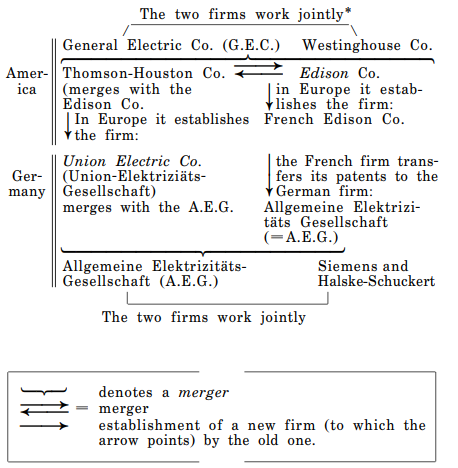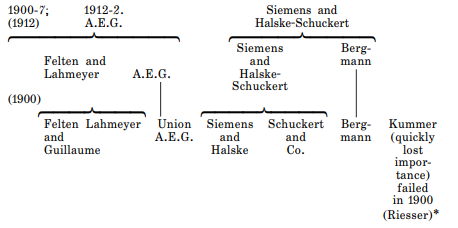
The electrical industry trust:
“The Path of the Electric Trust” by Kurt Heinig (Berlin). (Die Neue Zeit, 1912) (June 28, 1912), 30th year, Vol. 2, p. 474.)
An excellent illustration of imperialism[1]:
In 1907, an agreement was concluded between the A.E.G. (Allgemeine Elektrizitäts-Gesellschaft) and the G.E.C. (General Electric Company)
|
A.E.G. Concern G.E.C. Trust |
||
on division of the world.
G.E.C.—U.S.A. and Canada.
A.E.G.—Germany, Austria-Hungary, Russia, Holland, Denmark, Switzerland, Turkey, the Balkans.
| Turnover (mill. marks) |
No. of employees |
Net profit (mill. marks) |
||||
| G.E.C.(U.S.A.) | 1907 | 252 | 28,000 | 35.4 | ||
| 1910 | 298 | 32,000 | 45.6 | |||
| A.E.G. (Germany) | 1907 | 216 | 30,700 | 14.5 | ||
| 1911 | 362 | 60,800 | 21.7 | |||
| 298+262=660 million marks | ||||||
|
Special (secret) agreements on “subsidiary companies”. “In addition, mutual exchange of inventions and experiments!” (p. 475). |
N.B. |
The number of companies (mostly joint-stock companies) in which the A.E.G. “has a controlling interest” is 175-200 (p. 484). Of these, the six chief companies have a capital of about 750 million marks, while the total capital of all of these companies is probably about 1,1500 million marks.[2]
The number of “manufacturing companies” is 16
|
production of rubber—cables—quartz lamps—insula- tors—railway signals—motor cars—typewriters—air- craft, etc. |
||||
|
Production of raw material, etc., by the same enterprise is characteristic of modern industry. |
N.B. |
1) The number of direct A.E.G. agencies abroad = 34 (of which 12 are joint-stock companies)[3]
| 1) | 1. | St. Petersburg | 7. | Rumania | Altogether in ten countries |
| and Warsaw | 8. | Vienna | |||
| 2. | Lisbon | 9. | Milan | ||
| 3. | Christiania | 10. | Copenhagen | ||
| 4. | Stockholm | South-West | |||
| 5. | Brussels | Africa | |||
| 6. | Paris | (((colony?))) | |||

The two firms work jointly[4]
Amer-
ica
Ger-many
General Electric Co. (G.E.C.)
Westinghouse Co.
Thomson-Houston Co.
→
←
Edison Co.
(merges with theEdison Co.
in Europe it estab- lishes the firm: French Edison Co.
In Europe it establishes the firm: Union Electric Co. (Union-Elektrizitäts-Gesellschaft)
merges with the A.E.G.
the French firm trans-fers its patents to the German firm:
Allgemeine Elektrizitäts Gesellschaft (A.E.G.) (=A.E.G.)
Allgemeine Elektrizitäts-Gesellschaft
Siemens and Halske-Schuckert
The two firms work jointly
[[BOX-ENDS:denotes a merger = merger establishment of a new firm (to which arrow points) by the old one.]]
|
...“there are no other electrical companies in the world completely independent, at least, of these two (A.E.G. and G.E.C.)” (p. 474)....[5] |
N.B. |

1900-7;(1912)
1912-2.A.E.G.
Felten and Lahmeyer (1900) A.E.G.
Felten Lahmeyer and Guillaume Union A.E.G.
Siemens and Halske-Schuckert
Siemens and Halske-Schuckert Berg-mann
Siemens and Halske Schuckert and Co. Berg-mann
Kummer (quickly lost impor-tance) failed in 1900 (Riesser)[6]
[1] See present edition, Vol. 22, pp. 247-48.—Ed.
[2] Ibid., p. 230.—Ed.
[3] Ibid., p. 247.—Ed.
[4] See present edition, Vol. 22, p. 247.—Ed.
[5] Ibid.—Ed.
[6] Ibid.—Ed.
| | |
| | | | | | | ||||||